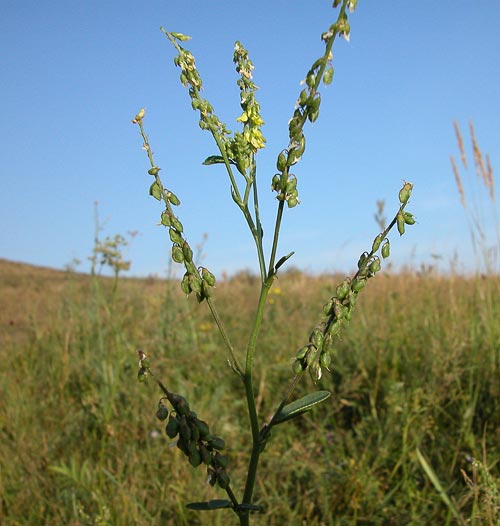Relatives
Melilotus dentatus (Waldst. et Kit.) Pers. - Dentated melilot
Taxonomic position.
Family Leguminosae Endl., genus Melilotus Mill.Synonyms.
Trifolium dentatum Waldst. et Kit., Melilotus brachystachys Bunge.Biology and morphology.
Biennial herb. It is tap-rooted with well-developed lateral branching. Stems are comparatively short (30-90 cm), rarely up to 140 cm tall, hollow. Leaves are large; lower leaflets elongated, elliptical or oval, 3.0-4.5 cm long, 2.0-2.5 cm wide; upper leaflets are linear, oval with prominent, thin veins with deeply serrated margins with 15-25 teeth on each side. The top of a leaflet ends in a tooth. Racemes are short (4-10 cm), dense and multi-floral (30-70 flowers per raceme). Flowers are small; pedicels are short. Calyx has 5 equally sized teeth, which are slightly pubescent. Corolla is yellowish or dark yellow; standard length is 3-6 mm. Pods are obovate, 3.0-5.0 mm long, 2.0-3.0 mm wide, with short style and reticulated, ridged coat, usually two-seeded. Seeds are small, round, 1.2-1.5 mm long, 1.2-1.5 mm wide, yellowish green or brown. This species has an indeterminate flowering period. Blossoms in June-September; seeds ripen in July-October. It is mainly cross-pollinated by honey bees. Chromosome number: 2n = 16.Distribution.
This species is distributed throughout the European part of the former USSR, the Caucasus, Western and Eastern Siberia, Kazakhstan and Middle Asia.Ecology.
Occurs in lowlands, in meadows (salty or wet), along wood edges, along rivers and as a ruderal plant in fields. It also grows in woods and in steppe and semi-desert areas up to the middle mountain zone.Utilization and economic value.
This is a very valuable forage crop, especially in saline soils. It is drought- and salt-resistant and winter hardy. It may be introducted into cultivation. It has good palatability for animals because of its lack of coumarin. It possesses a wide range of prominent characteristics, such as a high nutritive value during its vegetative stage of growth when grazed, during the pre-flowering stage for silage, and during the early-flowering stage for hay. It is an excellent source of nectar and pollen for honey bees and one of the best legumes for improving salinized soils.Reference citations:
Brezhnev D.D., Korovina O.N. 1980. Wild relatives of the cultivated plants of flora of the USSR. Leningrad: Kolos. 376 pp. (In Russian)Galushko, A.I. 1980. Flora of the Northern Caucasus. A field guide. Vol. 2. Rostov-na-Donu. 350 pp. (In Russian)
Grossheim A.A. 1945. Genus Melilotus. Flora of the USSR. Vol. 11. Moscow-Leningrad: USSR. 176-189 p. (In Russian)
Grossheim A.A. 1952. Genus Melilotus. Flora of the Caucasus. Vol. 5. Moscow-Leningrad: Academy of Science of the USSR. 192-194 p. (In Russian)
Hulten E., Fries M. 1986. Atlas of Northern European Vascular Plants North of the Tropic of Cancer. Vol. 1-3. Konigstein, 1172 p.
Mosel H. 1965. Comparative Chorology of the Flora of Central Europe. Jena. 583 p.
Nikitin V.V., Geldikhanov A.M. 1988. Plants of Turkmenistan. A field guide. Leningrad: Nauka. 680 pp. (In Russian)
Ovchinnikov P.N., ed. 1978. Flora of Tajikistan. Vol. 5. Leningrad: Nauka. 678 pp. (In Russian)
Pavlov N.B., ed. 1961. Flora of Kazakhstan. Vol. 5. Alma-Ata: AN KazSSR. 515 pp. (In Russian)
Polozhiy A.B., Malyshev L.I., eds. 1994. Flora of Siberia. Vol. 9. Novosibirsk: Nauka. 280 pp. (In Russian)
Phyodorov A.A., ed. 1987. Flora of the European part of the USSR. Vol. 6. 254 pp. (In Russian)
Schischkin V.K., Bobrov E.G., eds. 1945. Flora of the USSR. Vol. 11. Moscow-Leningrad: USSR. 129-176 p. (In Russian)
Suvorov V.V. 1950. Genus Melilotus. Flora of cultivated plants of the USSR. Vol. 13. Moscow-Leningrad. Issue 1. 345-502 p. (In Russian)
Vvedenskiy A.I., ed. 1981. Plants of Asia Minor. A field guide. Vol. 6. Tashkent: Fan. 394 pp. (In Russian)


